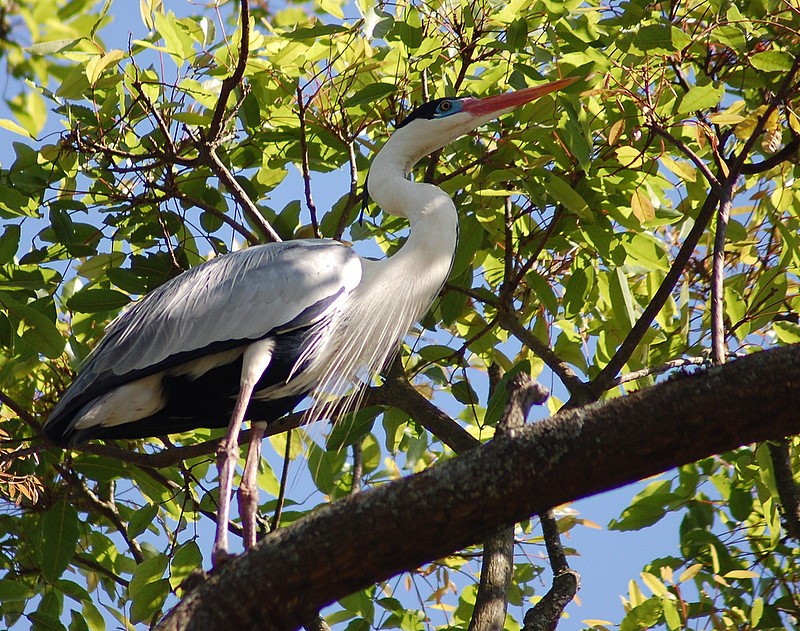Cocoi Heron
A species of Great herons, Also known as American White-necked Heron Scientific name : Ardea cocoi Genus : Great herons
Cocoi Heron, A species of Great herons
Also known as:
American White-necked Heron
Botanical name: Ardea cocoi
Genus: Great herons
Content
Description General Info
 Photo By Dario Sanches , used under CC-BY-SA-2.0 /Cropped and compressed from original
Photo By Dario Sanches , used under CC-BY-SA-2.0 /Cropped and compressed from original Description
The cocoi heron is the largest of the South American heron species and measures 95–130 cm (37.5–51 in) in length, although body sizes vary regionally; with southern individuals probably being the largest. Adult weight of both males and females can variously range from 1.14 to 3.2 kg (2.5 to 7 lb). In the adult, wing length has been recorded as 421–455 mm (16.5–18 in), tail length 161–173 mm (6.5–7 in), culmen from base 128.5–148.7 mm (5–6 in) and tarsus 179–192 mm (7–7.5 in). Sizes are similar to its North American counterpart, the great blue heron, although the latter may average slightly larger. The sexes are alike in both body size and colouration. It has a grey back and upper wings and a white S-shaped neck, thighs, under-tail wing coverts and scapulars; with black streaks on the neck and upper breast. The forehead and crown of the head are black and this black extends down to the eye region and up to the pointed crest hanging down the nape. There is also black streaking on the neck and black patches on sides of the lower breast and abdomen. Leg colour has been reported as black, brownish-grey or dark green. The iris is usually yellow and the bill dull yellow. The bare skin of the orbital region is pale greenish. In Argentina, breeding cocoi herons have been observed to have bright yellow bills with a red tinge at the base and dusky pink legs. In flight, its large wings make it a slow but sturdy and graceful flyer. The voice is a deep croak. Overall, the cocoi heron is similar in appearance to the grey heron; but the former has slightly darker colouration and a longer neck and crest. In the juvenile, the underparts are ash grey and streaked with buff. The neck and upper body surface are pale brownish with some ash grey tinge on the neck. Compared to the adult, the crown is duller and the under-tail coverts have a dusky streaking. Juveniles also lack the long plumes and occipital crest typical of the adult. Despite the paler colouration, the downy chick already shows the contrast between the dark head and pale neck typical of the adult. 
Size
1.3 m
Colors
Black
Gray
White
Life Expectancy
24 years
Nest Placement
Tree
Feeding Habits
Cocoi Heron primarily consumes fish, including whitemouth croaker and various other species, augmenting its diet with mammals, amphibians, insects, carrion, and crustaceans. It hunts by striking with its bill, often feeding solitarily by day or nocturnally, depending on the region. Unique adaptations include exploiting diverse foraging sites and dietary flexibility when near colonies.
Habitat
The cocoi Heron is a versatile wader occupying diverse wetland habitats away from densely forested areas. Its surrounding include lakefronts, swamps, rivers, estuaries, and occasionally grasslands and beaches. Gallery forests adjacent to water bodies and small watercourses also serve as feeding grounds. This species is typically found in lowland wetlands but is known to inhabit altitudes up to 2550 meters. It avoids arid coastlines and dense interiors of forests, favoring marshy zones within or near forested regions.
Dite type
Piscivorous
General Info
Feeding Habits
Bird food type
Distribution Area
The cocoi heron occurs throughout much of South America except in the Andes and in some parts of Argentina. It is native in Argentina, Panama, Suriname, Colombia, Venezuela, Bolivia, Brazil, Chile, Ecuador, French Guiana, Guyana, Paraguay, Peru and Uruguay. Overall, the cocoi heron is notably widespread and ranges from Central America to the mainland shores on the Strait of Magellan, but is rarely found further south than Chubut in Argentina. It has an estimated extent of occurrence of 20600000 km. It inhabits the wetter parts of the Chaco and occurs as a vagrant in the Falkland Islands, Saint Helena, Ascension Island and Tristan da Cunha. It is a regular, non-breeding visitor to Trinidad and Tobago. The habitat comprises almost any body of water or wetland away from dense forest; including lake shores, swamps, rivers and estuaries. Gallery forest, grassland and beaches have also been reported to be suitable feeding grounds. Pastures appear to be disfavoured probably because these habitats harbour a large proportion of insects, which are less favoured as prey than fish and mammals. In the Falkland Islands, the habitat appears to comprise small streams. In one study in the Parana river, water with aquatic vegetation was found to be the most preferable, followed by open waters, with the lowest preference for beaches. This heron is found at elevations up to 2550 m above sea level. 
Species Status
The Cocoi heron is classified by the IUCN as Least Concern because of its extensive geographical range, apparently increasing population trend and large population size. Individuals in some territories are affected by agrochemicals, environmental modification and human interference with nests and eggs; but these issues do not constitute damaging threats and therefore do not threaten the species with extinction. 
Scientific Classification
Phylum
Chordates Class
Birds Order
Pelicans and Relatives Family
Herons Genus
Great herons Species
Cocoi Heron